Bihar Board 12th Maths Objective Questions and Answers
Bihar Board 12th Maths Objective Answers Chapter 10 Vector Algebra
Question 1.
If \(\left(\frac{1}{2}, \frac{1}{3}, n\right)\) are the direction cosines of a line, then the value of n is
(a) \(\frac{\sqrt{23}}{6}\)
(b) \(\frac{23}{6}\)
(c) \(\frac{2}{3}\)
(d) \(\frac{3}{2}\)
Answer:
(a) \(\frac{\sqrt{23}}{6}\)
Question 2.
Find the magnitude of vector \(3 \hat{i}+2 \hat{j}+12 \hat{k}\).
(a) √157
(b) 4√11
(c) √213
(d) 9√3
Answer:
(a) √157
Direction (3 – 5): Study the given parallelogram and answer the following questions.

Question 3.
Which of the following represents equal vectors?
(a) a, c
(b) b, d
(c) b, c
(d) m, d
Answer:
(b) b, d
Question 4.
Which of the following represents collinear but not equal vectors?
(a) a, c
(b) b, d
(c) b, m
(d) Both (a) and (b)
Answer:
(a) a, c
Question 5.
Which of the following represents coinitial vector?
(a) c, d
(b) m, b
(c) b, d
(d) Both (a) and (b)
Answer:
(d) Both (a) and (b)
Question 6.
The unit vector in the direction of the sum of vectors
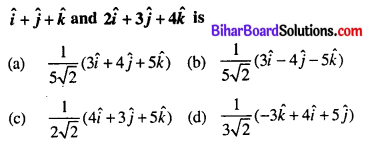
Answer:
(a) \(\frac{1}{5 \sqrt{2}}(3 \hat{i}+4 \hat{j}+5 \hat{k})\)
Question 7.
The vectors \(3 \hat{i}+5 \hat{j}+2 \hat{k}, 2 \hat{i}-3 \hat{j}-5 \hat{k}\) and \(5 \hat{i}+2 \hat{j}-3 \hat{k}\) form the sides of
(a) Isosceles triangle
(b) Right triangle
(c) Scalene triangle
(d) Equilaterala triangle
Answer:
(d) Equilaterala triangle
Question 8.

Answer:
(d) α = ±1, β = 1
Question 9.
The vectors \(a=x \hat{i}-2 \hat{j}+5 \hat{k}\) and \(b=\hat{i}+y \hat{j}-z \hat{k}\) are collinear, if
(a) x =1, y = -2, z = -5
(b) x= 1.2, y = -4, z = -10
(c) x = -1/2, y = 4, z = 10
(d) All of these
Answer:
(d) All of these
Question 10.
The vector \(\hat{i}+x \hat{j}+3 \hat{k}\) is rotated through an angle θ and doubled in magnitude, then it becomes \(4 \hat{i}+(4 x-2) \hat{i}+2 \hat{k}\). The value of x is
(a) \(\left\{-\frac{2}{3}, 2\right\}\)
(b) \(\left\{\frac{1}{3}, 2\right\}\)
(c) \(\left\{\frac{2}{3}, 0\right\}\)
(d) {2, 7}
Answer:
(a) \(\left\{-\frac{2}{3}, 2\right\}\)
Question 11.
Three points (2, -1, 3), (3, -5, 1)and (-1, 11, 9) are
(a) Non-collinear
(b) Non-coplanar
(c) Collinear
(d) None of these
Answer:
(c) Collinear
![]()
Question 12.
The points with position vectors \(60 \hat{i}+3 \hat{j}, 40 \hat{i}-8 \hat{j}\) and \(a \hat{i}-5 \hat{j}\) are collinear if
(a) a = -40
(b) a = 40
(c) a = 20
(d) None of these
Answer:
(a) a = -40
Question 13.
The position vectors of the points A, B, C are \((2 \hat{i}+\hat{j}-\hat{k}),(3 \hat{i}-2 \hat{j}+\hat{k})\) and \((\hat{i}+4 \hat{j}-3 \hat{k})\) respectively. These points
(a) form an isosceles triangle
(b) form a right angled triangle
(c) are collinear
(d) form a scalene triangle
Answer:
(a) form an isosceles triangle
Question 14.
The figure formed by the four points \(\hat{i}+\hat{j}-\hat{k}\), \(2 \hat{i}+3 \hat{j}, 5 \hat{j}-2 \hat{k}\) and \(\hat{k}-\hat{j}\) is
(a) trapezium
(b) rectangle
(c) parallelogram
(d) None of these
Answer:
(d) None of these
Question 15.
If x coordinate of a point P of a line joining the points Q(2, 2, 1) and R(5, 2, -2) is 4, then the z coordinate of P is
(a) -2
(b) -1
(c) 1
(d) 2
Answer:
(b) -1
![]()
Question 16.
If O is origin and C is the mid point of A(2, -1) and B(-4, 3), then the value of OC is
(a) \(\hat{i}+\hat{j}\)
(b) \(\hat{i}-\hat{j}\)
(c) \(-\hat{i}+\hat{j}\)
(d) \(-\hat{i}-\hat{j}\)
Answer:
(c) \(-\hat{i}+\hat{j}\)
Question 17.
The vectors AB = \(3 \hat{i}+4 \hat{k}\) and AC = \(A C=5 \hat{i}-2 \hat{j}+4 \hat{k}\) are the side of a ΔABC. The length of the median through A is
(a) √18
(b) √72
(c) √33
(d) √288
Answer:
(c) √33
Question 18.
The summation of two unit vectors is a third unit vector, then the modulus of the difference of the unit vector is
(a) √3
(b) 1 – √3
(c) 1 + √3
(d) -√3
Answer:
(a) √3
Question 19.
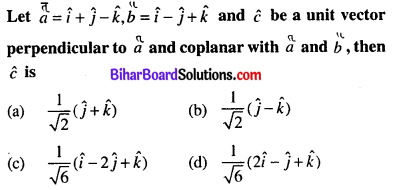
Answer:
(d) \(\frac{1}{\sqrt{6}}(2 \hat{i}-\hat{j}+\hat{k})\)
Question 20.
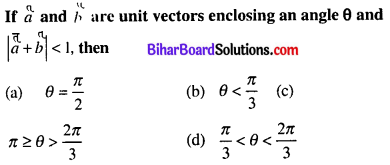
Answer:
(c) \(\pi \geq \theta>\frac{2 \pi}{3}\)
Question 21.
Let a, b and c be vectors with magnitudes 3, 4 and 5 respectively and a + b + c = 0, then the values of a.b + b.c + c.a is
(a) 47
(b) 25
(c) 50
(d) -25
Answer:
(d) -25
Question 22.
If |a| = |b| = 1 and |a + b| = √3, then the value of (3a – 4b).(2a + 5b) is
(a) -21
(b) \(-\frac{21}{2}\)
(c) 21
(d) \(\frac{21}{2}\)
Answer:
(b) \(-\frac{21}{2}\)
Question 23.

Answer:
(c) \(\frac{1}{\sqrt{2}}(\hat{i}+\hat{j})\)
Question 24.
If |a – b| = |a| = |b| = 1, then the angle between a and b is
(a) \(\frac{\pi}{3}\)
(b) \(\frac{3 \pi}{4}\)
(c) \(\frac{\pi}{2}\)
(d) 0
Answer:
(a) \(\frac{\pi}{3}\)
Question 25.

Answer:
(d) |a|2
Question 26.
a, b, c are three vectors, such that a + b + c = 0, |a|= 1, |b|= 2, |c|= 3, then a.b + b.c + c is equal to
(a) 0
(b) -7
(c) 7
(d) 1
Answer:
(b) -7
Question 27.
If |a + b| = |a – b|, then angle between a and b is (a ≠ 0, b ≠ 0)
(a) \(\frac{\pi}{3}\)
(b) \(\frac{\pi}{6}\)
(c) \(\frac{\pi}{4}\)
(d) \(\frac{\pi}{2}\)
Answer:
(d) \(\frac{\pi}{2}\)
Question 28.
If a and b are two unit vectors inclined to x-axis at angles 30° and 120° respectively, then |a + b| equals
(a) \(\sqrt{\frac{2}{3}}\)
(b) √2
(c) √3
(d) 2
Answer:
(d) 2
![]()
Question 29.
If the angle between \(\hat{i}+\hat{k}\) and \(\hat{i}+\hat{j}+a \hat{k}\) is \(\frac{\pi}{3}\), then the value of a is
(a) 0 or 2
(b) -4 or 0
(c) 0 or -3
(d) 2 or -2
Answer:
(b) -4 or 0
Question 30.
The length of longer diagronai of the parallelogram constructed on 5a + 2b and a – 3b. If it is given that
|a| = 2√2, |b| = 3 and angle between a and b is \(\frac{\pi}{4}\), is
(a) 15
(b) √113
(c) √593
(d) √369
Answer:
(c) √593
Question 31.
If a, b, c are unit vectors, then |a – b| + |b – c| + |c – a| does not exceed
(a) 4
(b) 9
(c) 8
(d) 6
Answer:
(b) 9
Question 32.
Find the value of λ so that the vectors \(2 \hat{i}-4 \hat{j}+\hat{k}\) and \(4 \hat{i}-8 \hat{j}+\lambda \hat{k}\) are perpendicular.
(a) -15
(b) 10
(c) -40
(d) 20
Answer:
(c) -40
Question 33.
The dot product of a vector with the vectors \(\hat{i}+\hat{j}-3 \hat{k}, \hat{i}+3 \hat{j}-2 \hat{k}\) and \(2 \hat{i}+\hat{j}+4 \hat{k}\) are 0, 5 and 8 respectively. Find the vector.
(a) \(\hat{i}+2 \hat{j}+\hat{k}\)
(b) \(-\hat{i}+3 \hat{j}-2 \hat{k}\)
(c) \(\hat{i}+2 \hat{j}+3 \hat{k}\)
(d) \(\hat{i}-3 \hat{j}-3 \hat{k}\)
Answer:
(a) \(\hat{i}+2 \hat{j}+\hat{k}\)
![]()
Question 34.
If a, b, c are three mutually perpendicular vectors of equal magnitude, find the angle between a and a + b + c.
(a) \(\cos ^{-1}(1 / \sqrt{3})\)
(b) \(\cos ^{-1}(1 / 2 \sqrt{2})\)
(c) \(\cos ^{-1}(1 / 3 \sqrt{3})\)
(d) \(\cos ^{-1}(1 / 2 \sqrt{3})\)
Answer:
(a) \(\cos ^{-1}(1 / \sqrt{3})\)
Question 35.
Find the angle between the vectors a + b and a – b if a = \(2 \hat{i}-\hat{j}+3 \hat{k}\) and b = \(b=3 \hat{i}+\hat{j}-2 \hat{k}\)
(a) \(\frac { \pi }{ 6 }\)
(b) \(\frac { \pi }{ 3 }\)
(c) \(\frac { \pi }{ 2 }\)
(d) 0
Answer:
(c) \(\frac { \pi }{ 2 }\)
Question 36.
If a = \(2 \hat{i}+\hat{j}+2 \hat{k}\) and b = \(5 \hat{i}-3 \hat{j}+\hat{k}\), then the projection of b on a is
(a) 3
(b) 4
(c) 5
(d) 6
Answer:
(a) 3
Question 37.
Let \(a=\hat{i}+2 \hat{j}+\hat{k}, b=\hat{i}-\hat{j}+\hat{k}, c=\hat{i}+\hat{j}-\hat{k}\). A vector coplanar to a and b has a projection along c of magnitude \(\frac{1}{\sqrt{3}}\), then the vector is
(a) \(4 \hat{i}-\hat{j}+4 \hat{k}\)
(b) \(4 \hat{i}+\hat{j}-4 \hat{k}\)
(c) \(2 \hat{i}+\hat{j}+\hat{k}\)
(d) None of these
Answer:
(a) \(4 \hat{i}-\hat{j}+4 \hat{k}\)
Question 38.
The component of i in the direction of the vector \(\hat{i}+\hat{j}+2 \hat{k}\) is
(a) √6
(b) 6
(c) 6√6
(d) \(\frac{\sqrt{6}}{6}\)
Answer:
(d) \(\frac{\sqrt{6}}{6}\)
![]()
Question 39.
Find the projection of b + c on a where a = \(\hat{i}+2 \hat{j}+\hat{k}\), b = \(\hat{i}+3 \hat{j}+\hat{k}\) and c = \(\hat{i}+\hat{k}\).
(a) \(\frac { 5 }{ \surd 3 }\)
(b) 2√2
(c) \(\frac { 3 }{ \surd 2 }\)
(d) \(\frac { 10 }{ \surd 6 }\)
Answer:
(d) \(\frac { 10 }{ \surd 6 }\)
Question 40.
If a = \(\hat{i}+\hat{j}+\hat{k}\), b = \(\hat{i}+3 \hat{j}+5 \hat{k}\) and c = \(7 \hat{i}+9 \hat{j}+11 \hat{k}\), then the area of parallelogram having diagonals a + b and b + c is
(a) 4√6
(b) \(\frac{1}{2} \sqrt{21}\)
(c) \(\frac{\sqrt{6}}{2}\)
(d) √6
Answer:
(a) 4√6
Question 41.
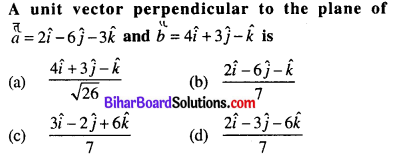
Answer:
(c) \(\frac{3 \hat{i}-2 \hat{j}+6 \hat{k}}{7}\)
Question 42.
The area of parallelogram whose adjacent sides are \(\hat{i}-2 \hat{j}+3 \hat{k}\) and \(2 \hat{i}+\hat{j}-4 \hat{k}\) is
(a) 10√6
(b) 5√6
(c) 10√3
(d) 5√3
Answer:
(b) 5√6
Question 43.
If AB × AC = \(2 \hat{i}-4 \hat{j}+4 \hat{k}\), then the are of ΔABC is
(a) 3 sq. units
(b) 4 sq. units
(c) 16 sq. units
(d) 9 sq. units
Answer:
(a) 3 sq. units
Question 44.
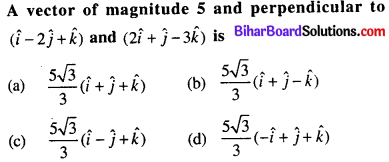
Answer:
(a) \(\frac{5 \sqrt{3}}{3}(\hat{i}+\hat{j}+\hat{k})\)
Question 45.
|a × b|2 + |a.b|2 = 144 and |a| = 4, then |b| is equal to
(a) 12
(b) 3
(c) 8
(d) 4
Answer:
(b) 3
Question 46.
If |a × b| = 4 and |a.b| = 2, then |a|2 |b|2 is equal to
(a) 2
(b) 6
(c) 8
(d) 20
Answer:
(d) 20
Question 47.

Answer:
(c) \(\hat{i}\)
Question 48.
The two vectors a = \(2 \hat{i}+\hat{j}+3 \hat{k}\) and b = 4 \hat{i}-\lambda \hat{j}+6 \hat{k} ae parallel, if λ is equal to
(a) 2
(b) -3
(c) 3
(d) 2
Answer:
(d) 2
Question 49.
If |a|= 5, |b|= 13 and |a × b|= 25, find a.b
(a) ±10
(b) ±40
(c) ±60
(d) ±25
Answer:
(c) ±60
Question 50.
Find the value of λ so that the vectors \(2 i-4 \hat{j}+\hat{k}\) and \(4 i-8 \hat{j}+\lambda \hat{k}\) are parallel.
(a) -1
(b) 3
(c) -4
(d) 2
Answer:
(d) 2
![]()
Question 51.
If a + b + c = 0, then a × b =
(a) c × a
(b) b × c
(c) 0
(d) Both (a) and (b)
Answer:
(d) Both (a) and (b)
Question 52.
If a is perpendicular to b and c, |a| = 2, |b| = 3, |c| = 4 and the angle between b and c is \(\frac{2 \pi}{3}\), |abc| is equal to
(a) 4√3
(b) 6√3
(c) 12√3
(d) 18√3
Answer:
(c) 12√3
Question 53.

Answer:
(b) a
Question 54.

Answer:
(a) neither x nor y
Question 55.
If a, b, c are three non-coplanar vectors, then (a + b + c).[(a + b) × (a + c)] is
(a) 0
(b) 2[abc]
(c) -[abc]
(d) [abc]
Answer:
(c) -[abc]
Question 56.
If u, v and w are three non-coplanar vectors, then (u + v – w).[(u – v) × (v – w)] equals
(a) 0
(b) u.v × w
(c) u.w × v
(d) 3u.v × w
Answer:
(b) u.v × w
Question 57.
If unit vector c makes an angle \(\frac{\pi}{3}\) with \(\hat{i} \times \hat{j}\), then minimum and maximum values of \((\hat{i} \times \hat{j}) \cdot c\) respectively are
(a) 0, \(\frac{\sqrt{3}}{2}\)
(b) \(-\frac{\sqrt{3}}{2}, \frac{\sqrt{3}}{2}\)
(c) -1, \(\frac{\sqrt{3}}{2}\)
(d) None of these
Answer:
(b) \(-\frac{\sqrt{3}}{2}, \frac{\sqrt{3}}{2}\)
![]()
Question 58.
The volume of the tetrahedron whose conterminous edges are \(\hat{j}+\hat{k}, \hat{i}+\hat{k}, i+\hat{j}\) is
(a) \(\frac{1}{6}\) cu. unit
(b) \(\frac{1}{3}\) cu. unit
(c) \(\frac{1}{2}\) cu. unit
(d) \(\frac{2}{3}\) cu. unit
Answer:
(b) \(\frac{1}{3}\) cu. unit
Question 59.
If the vectors \(2 \hat{i}-3 \hat{j}, i+\hat{j}-\hat{k}\) and \(3 \hat{i}-\hat{k}\) form three concurrent edges of a parallelopiped, then the volume of the parallelopiped is
(a) 8
(b) 10
(c) 4
(d) 14
Answer:
(c) 4
Question 60.
The volume of the parallelopiped whose edges are represented by \(-12 \hat{i}+\alpha \hat{k}, 3 j-\hat{k}\) and \(2 \hat{i}+j-15 \hat{k}\) is 546 cu. units. Then α =
(a) 3
(b) 2
(c) -3
(d) -2
Answer:
(c) -3
Question 61.
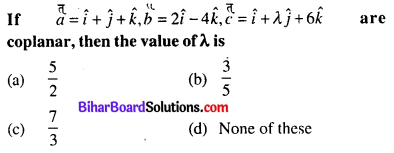
Answer:
(d) None of these
Question 62.

Answer:
(a) -2
Question 63.
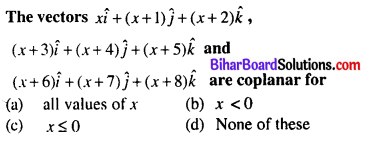
Answer:
(a) all values of x
Question 64.
If the vectors \(\hat{i}-2 \hat{j}+3 \hat{k},-2 \hat{i}+3 \hat{j}-4 \hat{k}, \lambda \hat{i}-\hat{j}+2 \hat{k}\) are coplanar, then the value of λ is equal to
(a) 0
(b) 1
(c) 2
(d) 3
Answer:
(a) 0
Question 65.
Find the value of λ if the vectors, a = \(2 \hat{i}-\hat{j}+\hat{k}\), b = \(\hat{i}+2 \hat{j}-3 \hat{k}\) and c = \(3 \hat{i}-\lambda \hat{j}+5 \hat{k}\) are coplanar.
(a) 4
(b) -2
(c) -6
(d) 5
Answer:
(a) 4
![]()
Question 66.
Find λ if the vectors \(\hat{i}-\hat{j}+\hat{k}, 3 \hat{i}+\hat{j}+2 \hat{k}\) and \(\hat{i}+\lambda \hat{j}-\hat{k}\) are coplanar.
(a) 5
(b) 12
(c) 15
(d) 8
Answer:
(c) 15
Question 67.
The vector in the direction of the vector \(\hat{i}-2 \hat{j}+2 \hat{k}\) that has magnitude 9 is

Answer:
(c) \(3(\hat{i}-2 \hat{j}+2 \hat{k})\)
Question 68.
The position vector of the point which divides the join of points 2a – 3b and a + b in the ratio 3 : 1 is
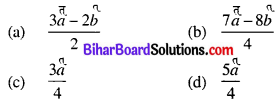
Answer:
(d) \(\frac{5 a}{4}\)
Question 69.
The angle between two vectors a and b with magnitudes √3 and 4, respectively and a.b = 2√3 is
(a) \(\frac{\pi}{6}\)
(b) \(\frac{\pi}{3}\)
(c) \(\frac{\pi}{2}\)
(d) \(\frac{5 \pi}{2}\)
Answer:
(b) \(\frac{\pi}{3}\)
Question 70.
Find the value of λ such that the vectors a = \(2 \hat{i}+\lambda \hat{j}+\hat{k}\) and b = \(\hat{i}+2 \hat{j}+3 \hat{k}\) are orthogonal.
(a) 0
(b) 1
(c) \(\frac{3}{2}\)
(d) \(-\frac{5}{2}\)
Answer:
(d) \(-\frac{5}{2}\)
![]()
Question 71.
The value of λ for which the vectors \(3 \hat{i}-6 \hat{j}+\hat{k}\) and \(2 \hat{i}-4 \hat{j}+\lambda \hat{k}\) are parallel is
(a) \(\frac{2}{3}\)
(b) \(\frac{3}{2}\)
(c) \(\frac{5}{2}\)
(d) \(\frac{2}{5}\)
Answer:
(a) \(\frac{2}{3}\)
Question 72.
The vectors from origin to the points A and B are a = \(2 \hat{i}-3 \hat{j}+2 \hat{k}\) and b = \(2 \hat{i}+3 \hat{j}+\hat{k}\), respectively then the area of triangle OAB is
(a) 340
(b) √25
(c) √229
(d) \(\frac{1}{2}\) √229
Answer:
(d) \(\frac{1}{2}\) √229
Question 73.
The vectors \(\lambda \hat{i}+\hat{j}+2 \hat{k}, \hat{i}+\lambda \hat{j}-\hat{k}\) and \(2 \hat{i}-\hat{j}+\lambda \hat{k}\) are coplanar if
(a) λ = -2
(b) λ = 0
(c) λ = 1
(d) λ = -1
Answer:
(a) λ = -2
Question 74.
If a, b, c are unit vectors such that a + b + c = 0, then the value of a.b + b.c + c.a is
(a) 1
(b) 3
(c) \(-\frac{3}{2}\)
(d) None of these
Answer:
(c) \(-\frac{3}{2}\)
Question 75.
If |a| = 4 and -3 ≤ λ ≤ 2, then the range of |λa| is
(a) [0, 8]
(b) [-12, 8]
(c) [0, 12]
(d) [8, 12]
Answer:
(c) [0, 12]
![]()
Question 76.
The number of vectors of unit length perpendicular to the vectors a = \(2 \hat{i}+\hat{j}+2 \hat{k}\) and b = \(\hat{j}+\hat{k}\) is
(a) one
(b) two
(c) three
(d) infinite
Answer:
(b) two